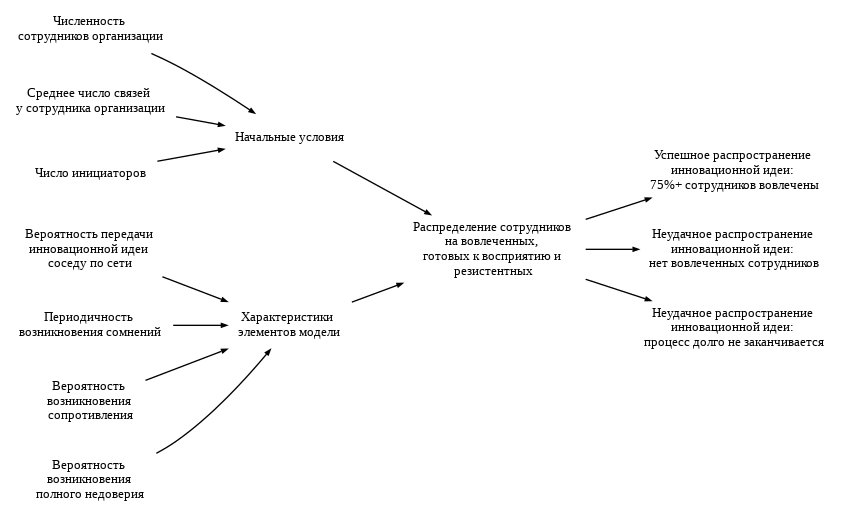Virus on a Network: различия между версиями
| Строка 7: | Строка 7: | ||
This model demonstrates the spread of a virus through a network. Although the model is somewhat abstract, one interpretation is that each node represents a computer, and we are modeling the progress of a computer virus (or worm) through this network. Each node may be in one of three states: susceptible, infected, or resistant. In the academic literature such a model is sometimes referred to as an SIR model for epidemics. | This model demonstrates the spread of a virus through a network. Although the model is somewhat abstract, one interpretation is that each node represents a computer, and we are modeling the progress of a computer virus (or worm) through this network. Each node may be in one of three states: susceptible, infected, or resistant. In the academic literature such a model is sometimes referred to as an SIR model for epidemics. | ||
{{#widget:iframe | |||
|url=https://netlogoweb.org/launch#https://netlogoweb.org/assets/modelslib/Sample%20Models/Networks/Virus%20on%20a%20Network.nlogo | |||
|width=800 | |||
|height=900 | |||
}} | |||
| Строка 30: | Строка 35: | ||
<!-- https://docs.google.com/spreadsheets/d/1cttXZLnkgASlo7eE64qLqqI9lEjGRcZWSy-g2MMjCjM/edit?usp=sharing --> | <!-- https://docs.google.com/spreadsheets/d/1cttXZLnkgASlo7eE64qLqqI9lEjGRcZWSy-g2MMjCjM/edit?usp=sharing --> | ||
=== Характеристики, описывающие состояние сети === | |||
В процессе проведения экспериментов элементы модели относятся к одному из 3 типов - вовлеченные (infected), готовые к восприятию (susceptible), резистентные (resistant). Так как число элементов модели зафиксировано начальными условиями, сумма этих групп будет равна заданному на старте количеству элементов (Number-of-nodes). | |||
{{#widget:Google Spreadsheet | |||
|key=1uDW9itM_AXmU7CSZ3wqaDKxlW25YXOf0qA8RLwMqP-Y | |||
|width=900 | |||
|height=400 | |||
}} | |||
<!-- https://docs.google.com/spreadsheets/d/1uDW9itM_AXmU7CSZ3wqaDKxlW25YXOf0qA8RLwMqP-Y/edit?usp=sharing --> | |||
=== Схема взаимосвязи переменных в модели === | === Схема взаимосвязи переменных в модели === | ||
| Строка 94: | Строка 110: | ||
<!-- [[Файл:NetworkOnVirus model.PNG|800px]] --!> | <!-- [[Файл:NetworkOnVirus model.PNG|800px]] --!> | ||
Версия 21:11, 9 марта 2024
| Описание модели | WHAT IS IT?
This model demonstrates the spread of a virus through a network. Although the model is somewhat abstract, one interpretation is that each node represents a computer, and we are modeling the progress of a computer virus (or worm) through this network. Each node may be in one of three states: susceptible, infected, or resistant. In the academic literature such a model is sometimes referred to as an SIR model for epidemics. |
|---|---|
| Область знаний | |
| Веб-страница - ссылка на модель | https://netlogoweb.org/launch#https://netlogoweb.org/assets/modelslib/Sample%20Models/Networks/Virus%20on%20a%20Network.nlogo |
| Видео запись | |
| Разработчики | |
| Среды и средства, в которых реализована модель | |
| Диаграмма модели | |
| Описание полей данных, которые модель порождает | |
| Модель создана студентами? | {{{Student-created}}}«{{{Student-created}}}» — не булево значение (да/нет). |
WHAT IS IT? This model demonstrates the spread of a virus through a network. Although the model is somewhat abstract, one interpretation is that each node represents a computer, and we are modeling the progress of a computer virus (or worm) through this network. Each node may be in one of three states: susceptible, infected, or resistant. In the academic literature such a model is sometimes referred to as an SIR model for epidemics.
Описание переменных модели
Переменные, задающие начальные условия
Переменные, задающие характеристики элементов модели
Характеристики, описывающие состояние сети
В процессе проведения экспериментов элементы модели относятся к одному из 3 типов - вовлеченные (infected), готовые к восприятию (susceptible), резистентные (resistant). Так как число элементов модели зафиксировано начальными условиями, сумма этих групп будет равна заданному на старте количеству элементов (Number-of-nodes).
Схема взаимосвязи переменных в модели
